-Trending Prospects (12/9) - Doug McDermott, Scott Machado, Henry Sims
-Trending Prospects (12/22) - Kris Joseph, Draymond Green, Chace Stanback
-Trending Prospects (12/23) - Will Barton, LeBryan Nash and Ricardo Ratliffe
-Trending Prospects (12/30) - Mike Moser, Kenny Boynton and Jarrod Jones
-Trending Prospects (1/6) - Herb Pope, Eric Griffin, Otto Porter, Quincy Acy
-Trending Prospects (1/12) - Arnett Moultrie, Kevin Jones, Robbie Hummel, Elias Harris
-Trending Prospects (1/20) - Andrew Nicholson, William Buford, Orlando Johnson, Tyshawn Taylor
-Trending Prospects (1/26) - Jordan Taylor, J'Covan Brown, Ashton Gibbs, Jorge Gutierrez
-Trending Prospects (2/3) - Tu Holloway, Maalik Wayns, Rodney Williams, John Shurna
-Trending Prospects (2/10) - Terrence Ross, B.J. Young, Darius Miller and Isaiah Canaan
John Jenkins, 6'4, Shooting Guard, Junior, Vanderbilt
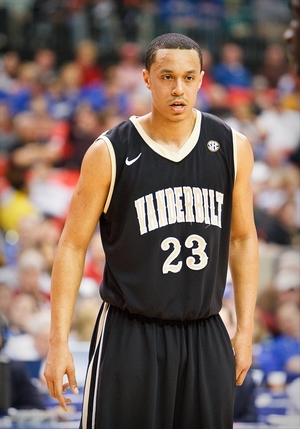
Joe Treutlein
Coming off a breakout sophomore season in which he led the Commodores in scoring, Jenkins has mostly held his pace as a junior, again leading Vanderbilt in scoring with 19.5 points per game for the 11th ranked offense in the NCAA according to kenpom.com.
Besides improving his 3-point percentages from 41% to 44% (an important development), Jenkins' stat line as a junior is practically a carbon copy of what he posted last year, and his outlook from an NBA perspective also remains largely the same from the last time we profiled him. One of the best shooters in the country with great versatility in getting his shot off, Jenkins has one clear-cut, high-level NBA skill, but still struggles to consistently stand out in other areas.
Looking at Jenkins' shooting game, there is ample reason to be optimistic about how it could translate to the NBA, as he has quite a few things working in his favor. For one, unlike most high-scoring NCAA shooting guards, Jenkins spends a good deal of time operating off the ball and often has short possessions when the ball comes his way. In likely transitioning to a much lower usage rate in the NBA, he already possesses the skills and tendencies fitting for that role.
Further, Jenkins is also at his best when he is operating as a spot-up shooter, coming off screens, or catching and going into a quick one or two-dribble pull-up. He's much more comfortable and efficient in these situations as opposed to operating in pure isolations, which he'll be seeing less of in the NBA.
Already sporting an outstanding TS% of 65% and an equally strong ratio of just 0.12 Turnovers:Possessions, Jenkins could actually become even more efficient in the NBA, where he should benefit from less defensive attention and the chance to be more selective with his looks.
Despite being a below average athlete and slightly undersized for the two-guard spot, there isn't much reason to believe Jenkins will have trouble getting his perimeter shot off against bigger, more athletic opponents in the NBA, as he's also unlikely to see the frequent double teams and traps he currently does as Vanderbilt's #1 option. He would probably excel most in a ball movement-heavy, up tempo offense that can get him the ball in space and on the move, where he possesses great mechanics and decision-making skills to get off high efficiency shots with ease.
In analyzing the rest of Jenkins' offensive game, he's still fairly limited at the NCAA level and there are question marks about what else other than shooting he could consistently contribute with in the NBA. Jenkins struggles both getting a good step on his man on dribble-drives and elevating for high-percentage shots in the lane, as he's held back by his below average athletic tools. He can make up for this somewhat with a strong mid-range game and if he better develops his floater, but it's hard to see him consistently contributing going to the basket in the short term.
Jenkins also could stand to improve as a passer, something he doesn't do much of for the Commodores with just 1.1 assists per game. He shows decent vision and ability making simple passes from the perimeter to cutters when he's looking, but often just isn't asked to do that in his team's offense, where he is heavily relied on for his scoring. Adjusting well here and expanding this area of his game could be helpful to his long term prospects, as this is the most likely area he can contribute something outside of his perimeter shooting.
Defensively, Jenkins' limitations are still evident, as he lacks the lateral quickness to consistently stay in front of guards, something that could be even more of a problem in the NBA. His effort level and fundamentals are solid enough, and he's decent from a positional defense standpoint, but it'll likely be a struggle for him to ever be an average defender in the NBA. Going to a team where he's very well utilized offensively to offset his defensive shortcomings will be key to how large an impact he has in his career.
Looking forward, Jenkins is an interesting prospect due to his one extremely potent skill, but his success will largely be dependent on where he's drafted due to his obvious limitations. Because he appears to be a truly elite shooter and has the intangible qualities well suited to his likely role, he should have a good chance of carving himself out a niche in the NBA, but how well he does will be very tied to the offensive scheme he plays in and how he's utilized by his coach. Maximizing his defensive and athletic abilities should be his biggest priority in pre-draft and beyond, as he likely largely is what he is from an offensive standpoint.
Hollis Thompson, 6-8, Small Forward, Junior, Georgetown
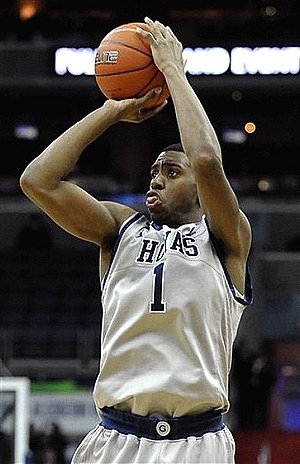
Walker Beeken
After surprisingly declaring for the 2011 NBA Draft following his sophomore season, Georgetown's Hollis Thompson ultimately decided to withdraw his name and return for his junior year, where he's continued to show steady improvement, while increasing his scoring and taking on a larger role for the Hoyas.
Thompson spent quite a bit of time playing as a face-up power forward in his first two seasons, but has been operating more on the wing as a small forward as a junior, where his game and physical attributes are better suited. Standing at 6-8 with a wiry frame that has improved since arriving at Georgetown, and a solid 6-10 wingspan, Thompson is a smooth athlete who is more comfortable on the perimeter on both ends of the floor.
As an NBA prospect, Thompson's calling card is his perimeter shooting, where he's proven to be outstanding, knocking down a career-high 48% from 3-point range this season, despite an increase in attempts. He has textbook form, deep range, and a quick release, which along with his size at 6'8, allow him to get off his shot without needing much space. Thompson ranks as one of the best shooters in college basketball, which in and of itself is enough to put him firmly on the NBA radar.
Thompson does most of his damage spotting up with his feet set, but he's also shown that he's capable of being run off screens, where he squares himself up nicely for his jumper. In addition to his catch-and-shoot abilities, Thompson is also very effective shooting off of a dribble or two on close-outs, connecting on an excellent 42% of his pull-up jumpers this season.
Thompson has become slightly less dimensional every year, taking a lesser proportion of his shots outside the arc in each of his three seasons in college, but still can't be considered anything more than an average shot-creator at best. He lacks the explosive first step and advanced ball-handling moves to get by his man off the dribble, only getting to the free throw line 2.8 times per-40 minutes pace adjusted, which is one of the worst rates amongst players in our Top-100 rankings.
With that said, he seems to play within himself and understands his limitations, turning the ball over on only 13% of his possessions and making 52% of his shots inside the arc, which could bode well for his potential as a role player at the NBA level, where he'd likely be utilized mainly as a floor spacer, spot shooter and opportunistic scorer.
Much of Thompson's potential to carve out a niche at the NBA level could depend on how well he's able to play on the defensive end. As we've mentioned before, his size and length are sufficient, but he's not a standout athlete, and he could still stand to add some strength to his frame to defend NBA small forwards on a regular basis.
He's been able to spend more time defending on the perimeter this season, and while he doesn't appear to be the toughest player, and is not immune to getting beat off the dribble at times, he does put a solid effort in, seems to understand positioning, and does a good job contesting shots with his footwork and length. Considering his size and wingspan, he shouldn't too have too much of an issue defending most NBA caliber small forwards, which is something teams will likely want to study more in private workout settings. The improvements he's shown on this end of the floor have been quite promising this season, though.
Overall, Thompson is a prospect who clearly has a skill to hang his hat on with his outstanding perimeter shooting. His average ball-handling skills may limit his upside in the eyes of some NBA scouts, but if he can continue to prove himself as a capable defender and make some slight improvements to his offensive game to increase his versatility, he has a great chance of carving out a niche in the league. NBA teams are always looking for perimeter shooters with prototypical size who can space the floor, and at age 20, it isn't a stretch to say that Thompson may not be a finished product.
Kim English, 6'6, Shooting Guard, Senior, Missouri
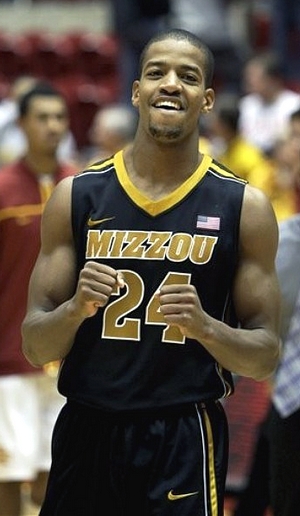
Kyle Nelson
To say that Kim English is having a breakout season is somewhat of an understatement. While he has been on DraftExpress' radar since he was in high school, he did very little during his sophomore and junior seasons to suggest that he would turn the corner and become a NBA legitimate prospect. The opposite has been true during his senior campaign, where English has developed into an efficient second option for a championship contender.
While English has good size for an NBA shooting guard at around 6'6 and a much-improved 195-pound frame, he only has average length (6-7 ½ wingspan) and could still stand to get stronger. He is not a very explosive athlete, but is a very fluid and coordinated player with nice quickness who plays with great aggressiveness and purpose.
Pursuant to our previous scouting reports, English remains a fairly one-dimensional player on the offensive end, with nearly 80% of his shots coming off jumpers. What differentiates his senior year from past seasons, however, is the rate in which his jumpers are falling, as he now ranks as one of the best shooters in all of college basketball.
While last season English converted a mediocre 36% of his attempts from both inside and outside of the arc, this year he is shooting 54% from 2-point range and an outstanding 46% for 3. Not only is he one of the nation's best 3-point shooters, but he is also the most efficient shooting guard in our database in effective field goal percentage.
On tape, English continues to show excellent mechanics including a quick, fluid release and solid elevation. He excels as a catch-and-shoot option, where he sees nearly half of his offensive possessions and where he currently converts an amazing 52% of his attempts. He has improved shooting off of screens, as well, doing a much better job of getting his body squared and feet set prior to leaving the floor.
English has also improved his shot-selection significantly this season, which helps explain his dramatically improved shooting percentages both inside and outside the arc. While last season about 33% of his jumpers came off the dribble, this year only 14% of his jumpers have come on pull-ups, which has helped make his team's entire offense flow more smoothly.
While English may be the best spot-up shooter in the country, he has never developed his game elsewhere to the extent that suggests he can be more than a shooting specialist at the next level. For one, his average physical profile and his below-average ball-handling skills limit his abilities as a slasher, and he has yet to demonstrate that he has developed, much beyond flashes of potential, in the way of an efficient mid-range arsenal. Despite taking far fewer pull-up jumpers this season, his accuracy on these types of shots has only increased marginally, from a horrid 15.5% to 24% this year.
English's lack of versatility may not be as much of a problem as it once appeared, however, as he displays excellent intangibles on the offensive end. Though his court vision is just average, he is a willing passer and an unselfish teammate. English is also a vocal leader on an off of the court, as well, communicating well with his teammates and leading by example through his toughness and work ethic. Furthermore and as has been documented at length throughout his career, English is an intelligent individual with an outstanding basketball IQ, which combined with his other intangibles are an ideal combination for a projected role player in the NBA.
Despite not being an incredibly prolific shot-creator, English has found more ways to contribute inside the arc this season, either by taking opposing power forwards off the dribble in a straight line, or moving intelligently within Missouri's dynamic half-court offense.
While English will be able to contribute immediately on the offensive end of the floor at the next level, his defensive potential is far less certain. As has been stated before, he has good fundamentals, staying in his stance with active hands and feet, but his length and lateral quickness are just average. While he does a solid job of keeping track of his man and staying involved even after he is beaten, there are still significant questions whether he can guard quicker guards at the next level, as he guards both post and perimeter players alike now for the undersized Missouri Tigers.
When it comes down to it, there are few players in the country who have improved their standing with NBA scouts than Kim English. He still has work to do before securing a spot on a NBA roster, but should have plenty of opportunities to showcase his talents on the biggest stages of college basketball as Missouri looks to make a Final Four run in March.
Elijah Johnson, 6'2, PG/SG, Junior, Kansas
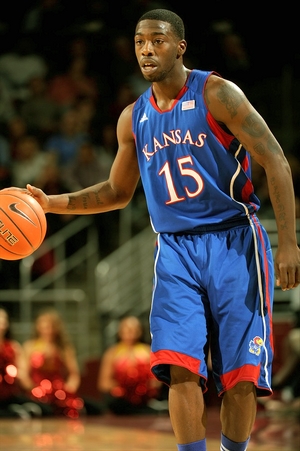
Joe Treutlein
After being relegated to minor roles coming off the bench in his first two seasons in Lawrence, Elijah Johnson has finally gotten his opportunity this season, averaging 31.7 minutes per game and playing a key role on Kansas' #5 ranked squad.
Johnson's physical tools were his strongest asset coming into this season, and that hasn't changed with his expanded role. Johnson's most impressive moments are largely his explosive finishes at the rim and his excellent speed going to the basket, which still remain his biggest selling points in projecting his long term potential.
In terms of offensive production, Johnson hasn't had the smoothest road this season, as he's averaging just 10.9 points per-40 minutes (second lowest in our top-100 rankings) and sees his points totals fluctuate wildly from game to game (including zero points in 37 minutes in a victory over Baylor last week).
Johnson has only gotten to the free throw line 20 times all season (second worst amongst all players in our top-100 rankings), while nearly two thirds of his field goal attempts come from beyond the arc, which emphasizes the fairly minor role he plays on this Kansas squad.
While he is an immensely gifted player from a tools standpoint and shows flashes of excellent ability at times as well, Johnson is still inconsistent in most areas of his game and has struggled especially finding a consistent role in the half court offense.
Johnson plays primarily off the ball in the Jayhawks offense, deferring to teammate Tyshawn Taylor to run the show, but still does some playmaking himself. He shows great ability throwing alley-oops to cutting bigs, making post entry passes, and operating on quick drive-and-kick passes, but doesn't get many opportunities to run the offense as a traditional point guard.
He's also shown excellent flashes running the pick-and-roll at times, showing good vision and taking advantage of his size and speed, but he isn't utilized very heavily in this aspect and isn't consistent knocking down the pull-up jumper when defenders go under the screen. While Johnson certainly has some intriguing assets as a shot creator and distributor, his lack of experience running the point full time and his still largely unpolished ball-handling leaves question marks about his ability to be a pure point at the next level, where he probably best fits as a combo guard similar to what he does now.
Johnson's still developing advanced ball-handling skills are probably the largest thing holding him back from excelling consistently in the half court, as it greatly limits the ways in which he can utilize his superb physical tools going to the basket. While showing a great first step and excellent rangy strides with the ball, Johnson struggles heavily in isolations where he isn't very confident taking his man one-on-one. The increased spacing at the next level, more frequent use of pick-and-rolls, and possibly being in a more up-tempo offense are all things that could enhance Johnson's abilities in this area, but he will still need to improve his basketball IQ and learn how to better use his tools offensively, as he really struggles to get to the basket and draw fouls or finish consistently.
Johnson's perimeter shot is another inconsistent aspect of his offense, as despite having solid mechanics and often looking pretty comfortable shooting the basketball, he's shooting under 30% from three-point range on 5.4 attempts per game despite seeing the vast majority of his shots in catch-and-shoot situations. Improving here would be very beneficial to his chances of carving out a niche in the NBA, and making significant strides either here or with his shot creation will likely be crucial to his long-term staying power.
On the defensive end, Johnson shows similar inconsistencies due to his still developing fundamentals and awareness, but a solid motor and his excellent physical tools due a much better job masking his shortcomings. His physical tools here are nothing short of elite at the point guard position and still very good for a combo or two guard, as he has all the strength and speed he'll ever need on this end of the court.
He struggles at times in isolations, either due to letting out of his stance early or overextending himself, but his tools allow him to recover so well that he often can make up for it, though that likely won't be true at the next level. Johnson is more consistently effective as a disruptive force in team defense and on pick-and-rolls, where his size and speed allow him to cover a lot of ground. His somewhat erratic tendencies are definitely helped by playing on a very well-coached, effective defense, though he'll likely have to tighten up his technique at the next level where he won't have a consistent tools advantage against his opponents.
Looking forward, Johnson is still a raw prospect who's just scratching the surface of his potential, but despite his increased minutes this season it's tough to say if he's markedly improved in any area from a skills standpoint. Really shoring up either his playmaking or perimeter shooting ability to give him more consistent production in the half court will be key to his success, and he could also help himself by really working towards his potential on the defensive end. Going to an up-tempo team that can best utilize his tools in transition, pick-and-roll potential, and strong passing ability would definitely help his chances of sticking, but he will likely still need to make some substantive improvements with his skills to find himself a long term niche.
With Tyshawn Taylor graduating this spring and seemingly few options on the horizon to replace his significant role as Kansas' primary ball-handler, Johnson may opt to stay for his senior year, which could be his best bet from a development and exposure standpoint, as he doesn't look very close to being able to contribute to a NBA team right now, and doesn't have much of a resume to fall back on.













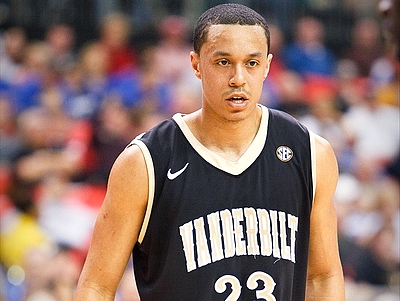


















Comments